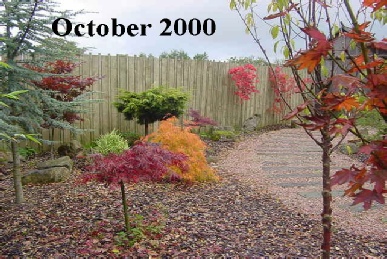Autumn in the Japanese Garden
Click any picture to enlarge
Use the back button on your browser to return
Suminigashi
As one leaves the Tea Garden
A view from the dry river bed
Osakasuki





A magical mix of colour
Few gardens can stimulate the senses in Autumn like the Japanese Garden.
It is true that there are few flowers, as such, in any Japanese garden, particularly in autumn, but the quite spectacular colours of the Japanese maples are undoubtedly the main attraction at this time of year. They are, of course, by no means the only source of such leaf or stem colour. Enkianthus, with its beautiful red stems glow brightly, as does the red orange of the leaves. The yellows of the leaves of the Tibetan cherry (Prunus Serrula), and of Acer Pensylvanicum. The bright red stems of the dogwood, Sibirica Westonbirt. The scarlet red of the Nyssa. The deep green of the Rhododendrons and various conifers. All combine to delight the senses and to make one marvel at the sheer brilliance of nature’s magical ways.
But the Japanese maples are surely in a league of their own.
Walk with me towards the Tea Garden of the Fujiyama Japanese Garden, in County Antrim, in Northern Ireland. A garden very much still in its infancy, but this area, in particular, planted up to bring the glory of autumn to the visitor.
One first comes upon the Acer Suminagashi, leaves aglow in their autumn finery. This is a large leaf cultivar, with seven lobes. The bright purple/red of spring changes to a deep maroon, then turns deep maroon red until in autumn showing off a leaf of bright crimson. This small specimen nestles just beside the Tea House in front of a pillar conifer of deep green.
On the other side of the Teahouse is Bloodgood, sporting a deep purple leaf so distinctive of this variety. The underside of the leaf is usually shiny dark green, and the later autumn colour a deep crimson. A strong growing variety, this tree will mature at about 5 metres.
Beside that a new addition this year is Acer Seiryu, a profusion of small orange red leaves. Seiryu is unusual in that it is an upright growing form of the dissectum maple, a variety which is usually of cascading or weeping form. The spring foliage is a pleasing bright green turning light green in summer. The autumn colour is quite spectacular, and can range through gold yellow into orange and crimson, or, as here, orange red.
Beside that one of the classic acers of all time, Acer Osakasuki. A hardy, sturdy grower, it has very large leaves for a palmatum. The normal leaf colour is a good rich green. but it is the intense crimson red autumn colour of the leaves of this beauty which have to be seen to be believed, and, quite literally, take your breath away. If you are destined to have only one Japanese maple in your garden, it must surely be Osakasuki.
Just opposite Osakasuki is an Acer Pensylvanicum, a snake bark maple. This acer is from the series Plananoidea, and is not classed as a Japanese maple. It has large yellow oval leaves in early autumn, quite striking in their own right.
I suppose if one has to have a personal favourite amongst the maples, my own must be Okagami. This one has deep purplish leaves during the summer, turning a deep green at the beginning of autumn, and then bursting forth in a profusion of deep orange scarlet/red. I have found myself standing in front of this small tree for ages in total wonder at the magnificence of mother nature. This delightful upright small tree matures at about 4 metres.
In front of this specimen is a miniature dissectum ‘Flavescens’ (green in summer, now yellow orange) and a dissectum ‘Garnet’, now boasting its own shade of crimson/scarlet. Opposite an enkianthus in stunning orange red, with bright red stems from its summer growth.
Passing along the path on one’s right is the yellow of the Prunus Serrula, the red of Acer Scarlet Sentinel, the orange yellow of Acer Griseum, and then the superb yellow pale orange of another Palmatum, Acer Senkaki (Sango Kaku), with its striking coral bark. A beauty indeed.
As one turns left one is met by the scarlet red of an Acer Atropupureum, a strong growing landscape tree which will reach possibly 10 metres high, and, nestling in behind, the orange and some years flame red of Acer Acontifolium (Dancing Peacock) which is a fern leaf maple. The tree here is yet small (only just over a metre high) but may reach up to 5 metres.
The sheer beauty and magic of the Japanese Garden in Autumn.
The sheer beauty and magic of the Japanese Maple.